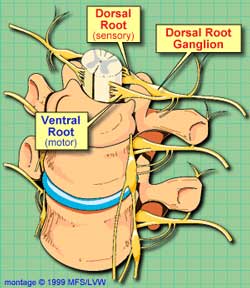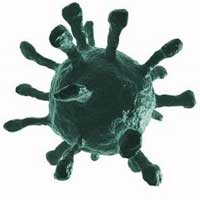Discuss this article on the forums
In this three part series we looked at the Light’s exciting work on ME/CFS. First – we looked at the Light’s attempt to validate their gene expression findings, then we examined what they believe may be ground zero for CFS, and finally we brought their findings together with a theory paper by Shapiro which asserted that a different kind of herpesvirus is at work in ME.
- Part I – Bad Reception? The Light Gene Expression Studies
- Part II – The Dorsal Ganglia – Ground Zero for ME?
- Part III – Varicella Zoster Virus, Shingles and ME/CFS – A New Herpesvirus for ME?
In Part IV we give the quickie version of the three papers. Thanks to the Lights and Judith Shapiro for their willingness to answer questions and, as always, to Dennis for his invaluable help getting the research papers.
Part I: the Study
 Drs. Alan and Kathleen Light in combination with Dr. Lucinda Bateman and others validate their prior findings that levels of receptors on white blood cells that pick up signs of muscle distress increase tremendously in people with CFS compared to healthy controls.
Drs. Alan and Kathleen Light in combination with Dr. Lucinda Bateman and others validate their prior findings that levels of receptors on white blood cells that pick up signs of muscle distress increase tremendously in people with CFS compared to healthy controls.
During their investigation they are able to pick out two subsets; a smaller group composed of about 30% of the study participants with a high incidence of ‘POTS’ (increased heart beat/dizziness, etc. after standing) and a fairly simple problem. A key gene that is supposed to transfer blood from non-working muscles to working muscles – does not get expressed during exercise – suggesting that further study could lead to a quick fix (if the drug companies get interested).
The problems in a larger group of ME/CFS patients is more problematic as exercise appears to throw their sensory, sympathetic nervous and immune systems into disarray. This group is more complex but a key receptor involved in both producing pain after exercise and causing inflammation stands out and the Lights hope, at some point, to find a drug company that will build a drug to block this receptor – thus hopefully turning off some of the pain, fatigue and inflammation occurring after exercise in ME.
Big Study – The Lights have been able to snag a Pfizer funded study that will examine if their unique approach to gene expression works. In this study they’ll follow CFS patients in severe pain to see how they react to Lyrica. If those patients who get better find that their gene expression levels are declining as well – the Lights have proven that they’ve found biomarkers for pain and fatigue in chronic fatigue syndrome – thus setting the stage for more studies and, hopefully, more drug company involvement.
 Part II – Ground Zero for ME/CFS – the Dorsal Ganglia?
Part II – Ground Zero for ME/CFS – the Dorsal Ganglia?
The Lights believe the receptor upregulation they’re seeing in white blood cells is mirrored in central gathering places for nerves called the dorsal root ganglia (DRG) that occur just outside the spinal column. These nerve centers relay information from sensory nerves to the brain and have been implicated in a variety of neuropathic conditions.
The Lights believe an that injury to these centers is causing them to put the sympathetic nervous (‘fight or flight’) system on alert constantly and to ramp up the pain and fatigue levels in patients. This constant state of alert has an extra cost, however and that cost is the tendency of the sympathetic nervous system to begin to ignore signals for more action.
The SNS may be turned on constantly but when it’s asked to do more – ie to send more blood to muscles during exercise- it refuses to do so – thus causing the acidic conditions in the muscles that cause pain and fatigue and and propel people with ME/CFS quickly into a state of anerobic energy production.
Other factors such as receptor upregulation in the immune cells in the brain and a gene which puts the ‘fight or flight’ system more quickly into play in people with CFS may play a role as well.
The Lights will begin to test their dorsal root ganglia theory in a study to commence soon.
Part III – A Different Herpesvirus for ME/CFS?: Varicella-Zoster, Shingles the Dorsal Root Ganglia and ME
 But what is actually causing the purported dorsal root ganglia dysfunction? It could be a variety of things but one may stand out. It turns out that the dorsal root ganglia aren’t just gathering places for sensory nerve cell bodies; they’re also, due to a leaky nerve/blood barrier, gathering places for herpesvirus infections.
But what is actually causing the purported dorsal root ganglia dysfunction? It could be a variety of things but one may stand out. It turns out that the dorsal root ganglia aren’t just gathering places for sensory nerve cell bodies; they’re also, due to a leaky nerve/blood barrier, gathering places for herpesvirus infections.
Judith Shapiro argues in a 2009 theory article that herpesviruses attracted to the nervous system such as varicella zoster virus (VZV) (the herpesvirus that causes chickenpox and shingles) are a more likely candidate for ME/CFS than more commonly studied herpesviruses. She proposes that a varicella-zoster infection of the dorsal root ganglia or other peripheral ganglia could readily account for a number of factors in CFS the acute onset, the wide variety of symptoms, the high misery/low fatality index and the post-exertional relapse found.
Confirmation of Shapiro’s theory will be difficult given the potentially severe consequences of interfering with the DRG but new herpesvirus drugs due to come on the market in the next couple of years, some of which are specifically targeted at VZV and the Lights focus on the dorsal root ganglia, should spur more interest into this intriguing theory of ME/CFS.
